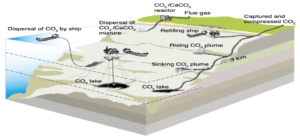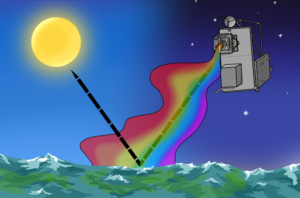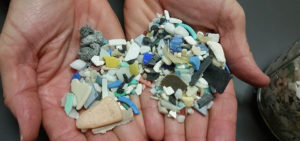In this third installment on ocean plastic pollution I’ll discuss how markets are being leveraged to get plastics out of the ocean and back into the economy. I’ll hit on market drivers and highlight some organizations that are paving the way. If you haven’t read parts one and two, check those out before starting here.
Recycled Plastic Market Drivers: Quality and Price
Retailers selling plastic goods want every replication of their product to be of high quality and look identical on the shelves. Their reputation and brand depend on it. Naturally, they want to accomplish this in the cheapest way possible without compromising quality. These two factors, price and quality (relative to virgin plastics), are the primary drivers for recycled plastics.
The price of plastic is unstable. Over the past year virgin HDPE resin has hovered around 50 to 70 cents per pound [11]. Recycled HDPE resin has averaged about 35 – 65 cents per pound [10]. These prices fluctuate, largely in response to the price of oil, a notoriously volatile commodity. For example, when oil prices collapsed in 2015, the price of virgin plastic dropped approximately 60 percent, making it just as cheap as recycled plastic. This caused many manufacturers to switch over from recycled plastic to the higher quality virgin material [12]. It’s equivalent to asking whether you would rather buy a used Honda Accord with 150,000 miles or a new model right off the showroom floor for the same price.
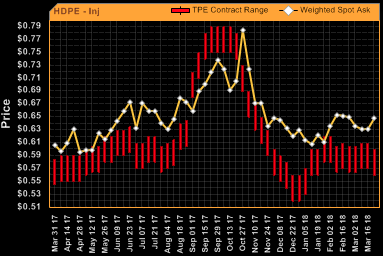
Late in 2017 China enacted an import ban on recycled plastic, sending the U.S. recycling industry (one of China’s largest suppliers of recycled plastic) into another turmoil [13]. Lower prices resulted from this demand-void which increased their attractiveness relative to virgin plastics, but margins were reduced necessitating higher sales volume to take-up the slack.
Plastic Separation
Recycled plastic is not perfect. To be used in manufacturing recycled plastic needs to be collected, separated, cleaned, shredded, melted, and then formed into plastic resin pellets that can be heated and transformed into new products. One of the biggest challenges in this whole process is just separation. On a chemical level, there are many different variants of plastics, even just within HDPE, and a minuscule amount of the wrong plastic in a batch can ruin the whole lot. It’s near impossible to completely separate all chemically dissimilar plastics, and thus the resulting resin is less pure than its virgin counterpart and more prone to defects in manufacturing.

For ocean-bound plastic collection, separation, and cleaning is more difficult. Ocean-bound plastic is harder to collect and aggregate when it is buried in the sand or floating in a creek. After spending some time outside in the elements, sun-bleached and broken-down plastics all look very similar, making separation even more difficult. Moreover, ultraviolet degradation alters the chemical structure of the plastic itself leading to similar plastics differing on a chemical level. Collectively, these issues lead to increased processing costs and a lower quality plastic resin.
In order to maintain quality standards recycled plastics are typically blended with virgin plastics. Depending on the product being made, the amount of recycled plastic could be anywhere from 10 to 90 percent of its composition. Products using ocean plastic typically fall in the lower range due to its generally poorer quality, again, depending on the product. To get more recycled plastic into the mix it needs to be cheaper and higher quality, factors that are unfortunately often at odds with one another.
Virgin No More
Buying and selling recycled plastics is a tough market. Building a business around ocean-bound plastic is even more difficult. The margins are thin and the market is dependent upon external forces. While the economic reasons for using recycled plastics are at times questionable, the environmental and social reasons are more obvious and are the primary drivers for first-movers in the recycled ocean-bound plastics market that is being developed. Like any market, in order to function properly it needs supply and demand. Let’s see who is leading the charge on both sides.
Creating a Supply of Ocean-Bound Plastic
Plastic processors and manufacturers need a steady supply of ocean-bound plastic for them to optimize on economies of scale. Challenging, but not an impossible task.
The Plastic Bank has risen to the challenge. Using some seed funding, the organization has set up a mini-market in Haiti where they provide individuals money, services, items, or even Blockchain tokens in exchange for collected plastic. Haiti has long suffered from poor waste management and much of their uncollected refuse litters the ground and inland waterways. Eventually it winds up in the sea. Through the Plastic Bank, average citizens now have a means to earn a basic living wage by collecting the plastic from beaches and waterways, ensuring that it never reaches the ocean. For the average Haitian this source of income is a life-changing proposition, potentially increasing their average daily earnings by a factor of six.

Since this pilot project began The Plastic Bank has attracted over 2,000 collectors, created 30 plastic marketplaces, and recycled over seven million pounds of plastic. They are now trying to replicate the model in Brazil and the Philippines [2]. By having multiple collection markets, the group is able to maintain a relatively constant flow of plastics that they can sell to plastic processors and manufacturers. This model benefits the community financially and environmentally, which is one of the reasons the group has branded the plastic they sell as ‘Social Plastic’. In order to sell this Social Plastic however, there needs to be a demand for the collected plastic.
Demand for Ocean Plastic
NextWave is a consortium of companies that have banded together under a pledge to incorporate more ocean-bound recycled plastics into their respective businesses. The goal is to use recycled plastic, like that collected by The Plastic Bank, in their products that have traditionally used virgin materials.
A number of companies have taken NextWave’s pledge, including some household names like Dell, General Motors, Herman Miller, and Trek bicycles, among others. According to the consortium, they anticipate that they “will divert more than 3 million pounds of plastics and nylon based fishing gear from entering the ocean within 5 years, equivalent to keeping 66 million water bottles from washing out to sea [3].” This equates to roughly 300 tons a year on average, which is about twice what the tech devices discussed in Part 2 were accomplishing.
Dell was one of the founding members of this consortium and they’ve been working hard on incorporating ocean bound plastic into their products. During their first pilot project in Haiti, Dell was able to repurpose about 16,000 pounds of ocean-bound plastic over the course of a year [4] and use it in packaging for their products. Eight tons of recycled plastic may not sound like much for a behemoth like Dell, but it was a pilot; if Dell takes this effort to full scale the impact would be huge.

Number One with Ocean Plastic
Aside from NextWave, there are other companies that are trying to incorporate ocean-bound plastic into their products. In fact, there seems to be a marketing play for these companies to be the world’s first to use ocean plastic in their respective industries.
For example, Method claims to be the first company to manufacture a plastic bottle using a blend of ocean plastic and other recyclables for their soap containers [5]. Procter and Gamble’s Head and Shoulders shampoo brand have laid claim to the world’s first recyclable shampoo bottle made from ocean-bound plastic. Although only a quarter of the bottle is made from recycled ocean plastic, the company estimates that when the initiative is scaled up across its entire European supply chain it will consume 2,600 metric tons of recycled plastic each year, or 650 tons of ocean-bound plastic.

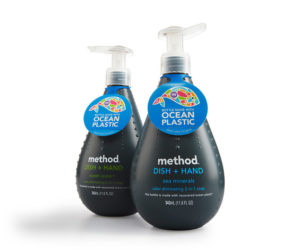
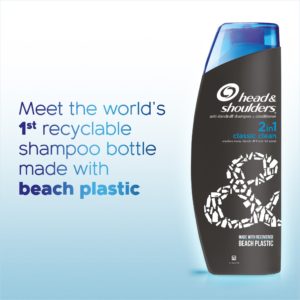
Norton Point, through a partnership with the Plastic Bank and the Ocean Conservancy, manufacture the world’s first ocean plastic sunglasses. A portion of the proceeds from selling these stylish shades gets reinvested into more cleanup initiatives, a part of Norton Point’s promise to remove one pound of plastic for every pair of glasses they sell. Lastly, there is Bureo: the first company to make skateboards and Jenga board game sets from recycled fishing nets. They also make other products such as surfboard fins and shirts, also using ocean plastic. Through their recycling program in Chile, Bureo has recycled over 80 metric tons of retired fishing gear to-date, equipment that might otherwise have turned into ghost nets at sea.

Message in a Bottle
Consumer demand for plastic is responsible for the current mess we’re in, but it can also be used to drive the solution. Due to external market forces recycling ocean plastic may not always make economic sense. But if consumers demand that their products use ocean-bound plastic, its market value will increase and incentivize more entrepreneurs to collect it before it ever reaches the ocean. Unlike the tech devices discussed in Part II, a market solution can be scaled up rapidly and have a truly global impact. Next time you’re out shopping, send a signal and buy something that uses recycled plastics.
References
[1] Biddle, David. “Recycling for Profit: The New Green Business Frontier” https://hbr.org/1993/11/recycling-for-profit-the-new-green-business-frontier
[2] The Plastic Bank. “What We Do”
https://www.plasticbank.org/what-we-do/
[3] The Lonely Whale. “NextWave”
https://www.lonelywhale.org/nextwave
[4] Dell. “Green Packaging and Shipping”
https://www.dell.com/learn/us/en/uscorp1/corp-comm/ocean-plastics
[5] Method.
http://methodhome.com/beyond-the-bottle/ocean-plastic/
[6] Plastics Today. “
https://www.plasticstoday.com/packaging/procter-gamble-launches-fairy-ocean-plastic-bottle-made-100-recycled-plastic/198944615157640
[7] Head and Shoulders. “The World’s First Recyclable Shampoo Bottle Made from Beach Plastic”
https://www.headandshoulders.com/en-us/whats-new/new-head-shoulders-bottle-to-be-made-with-recycled-beach-plastic
[8] Bureo https://bureo.co/pages/bureo-collection
[9] Dengler, Roni. PBS. “Humans have made 8.3 billion tons of plastic. Where does it all go?” July 19, 2017
https://www.pbs.org/newshour/science/humans-made-8-3-billion-tons-plastic-go
[10] Block, Debbie. Plastics Technology “2017: A Mixed Bag for Recycled Plastics Pricing So Far” Nov 30, 2017
https://www.ptonline.com/articles/2017-a-mixed-bag-for-recycled-plastics-pricing-so-far
[11] The Plastics Exchange
http://www.theplasticsexchange.com
[12] Smith, Stacey. NPR “Low Oil Prices Interfere With What Recyclers are Paid for Plastic” Jan 14, 2016
https://www.npr.org/2016/01/14/463010138/low-oil-prices-interfere-with-what-recyclers-are-paid-for-plastic
[13] Phillips, Erica. The Wall Street Journal. “Trash Talk: Price of Recycables Sinks After China Bans U.S. Scrap” Oct 20, 2017
https://www.wsj.com/articles/less-cash-to-buy-trash-after-chinas-ban-1508493603

